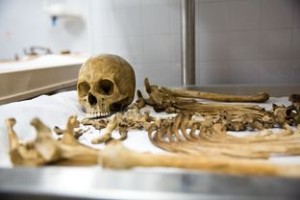http://www.texastribune.org/2015/07/25/texas-body-farm-research-uses-corpses-solve-crimes/

- by Ally Mutnick
SAN MARCOS — A drone flew over the sprawling hills of Freeman Ranch about two years ago, capturing a monochromatic photograph. The gray landscape was grass and dirt and the white spots denoted excessive vegetation. The black flecks were decomposing corpses.
It was exactly the picture that Daniel Wescott, a forensic anthropologist, and Gene Robinson, the owner of a search and rescue organization, were looking for to prove their suspicions that a plane equipped with the right technology could locate the dead.
“We just had one of those eureka moments,” said Robinson, who is based in Wimberley. “We can put these two things together and suddenly we have a forensic tool.”
The ranch is home to about 50 human corpses donated to the Forensic Anthropology Center at Texas State University, which uses them to conduct research that can help medical examiners identify bodies, rescuers find missing persons and law enforcement solve crimes.
Dead bodies are peppered across Texas State’s gated 26 acres on Freeman Ranch. Some are completely decayed down to bones loosely covered by tan, leathery skin, while more recent arrivals resemble the living except for the swollen flesh and colonies of flies laying eggs in facial orifices.
Wescott is the director of the center, known informally as a “body farm.” He helps design many of the research projects in the hopes that by controlling the conditions the body decomposes in — and knowing the biological facts of the person who died — the studies can offer insight on murders or unexplained deaths when much less information is available.
The drone flights are part of an ongoing study using near infrared imaging to detect corpses above and below the ground that are often not visible to the naked eye. The technology can also spot locations where a corpse was previously buried for up to two years after it has been removed.
“The search for clandestine bodies is a very time-consuming ordeal,” Wescott said. “Even then, a lot of times you can walk right by them and not realize that they’re there.”
Near infrared imaging picks up reflectance; as a corpse decays it releases carbon and nitrogen into the soil, decreasing the amount of light the soil reflects. At first, the influx of chemicals kills plants, but as it disperses into the area around the body it turns into a fertilizer causing extra vegetation, which reflects a lot of light.
The two extremes show up as black and white on the mostly gray near infrared imaging, giving anyone looking for a body, Robinson said, double the chances of finding of it.
The Texas State labs, which opened in 2008, are constantly churning out research. The placement and conditions of the bodies are purposeful; many are protected by metal-pole cages, but those that aren’t resemble a collection of scattered bones, pillaged by vultures and raccoons. Corpses are above and below ground as well as in both the sun and shade to compare the decay of each. Some bodies are wrapped tightly in tarp, part of a new study that will look at the rate of decay for a common modus operandi of disposal for murders.
The center grabbed national attention recently when it collected the remains of 80 undocumented immigrants who died after crossing the border. Found in a mass grave in Brooks County, the bodies were buried haphazardly, some covered only by trash bags and shopping bags.
Kate Spradley, a researcher and associate professor of anthropology at Texas State, leads a team working to identify the immigrants and send their remains home. The work is slow, and so far the team has confirmed three identities.